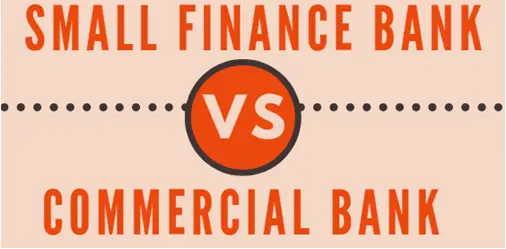Small Finance Bank Vs Commercial Bank
By Anupama Deshpande | February 13, 2018



Recently launched, Small Finance Bank's category is absolutely different from that of commercial bank. Small Finance Bank is called Differentiated Bank whose concept first came in the year 2007. After working on this concept, RBI granted in-principle approvals to 10 for Small Finance Bank (SFB) in September 2015. The main idea behind introduction of such banks by RBI is to target a specific market and customise these banks' operations on the basis of this target market's preferences.

Small Finance Bank offers limited range of products and services to their customers with an objective to provide financial inclusion to untapped and unserved sections of Indian population. Commercial Banks are already well established banks with their branch network across India.
Interested to know How to Negotiate a lower Interest rate on a Personal Loan?
Small Finance Bank
- Small finance banks were recommended by the NachiketMor Committee on Financial Inclusion
- Area of operations will be smaller
- Can's extend large loans
- 50% loans to Micro, Small and Medium Enterprises (MSME) Sector
- For Initial 3 years, 25% branches must be in rural areas to tap those areas
- Not allowed to set up a subsidiary to offer non banking financial services to the customers
- Target customers are MSME, Small Farmers, Small Businessman, Unorganized Workers, etc.
- Cooperative bank can't apply for license of small banks
- Small finance banks are governed by the provisions of Reserve Bank of India act 1934, Banking Regulation act 1949 and other relevant statutes
Commercial Bank
- Commercial Bank has no restrictions on providing any kind of products, functions and services to the customers
- Commercial banks in India can extend lending services such as home loans, personal loans, etc. without any restriction
- No cap on accepting deposits from its customers
- Can issue Debit as well as Credit Cards
- Commercial banks are allowed to invest the money they collect in form of deposits in open market
- Commercial banks can provide foreign exchange services however different banks charges are different for these services
Small Finance Bank Vs Commercial Bank
Find below major differences between Small Finance Bank and Commercial Bank
| Basis of Difference | Small Finance Bank | Commercial Bank |
|---|---|---|
| Who can promote | Individuals/ professional having 10 years experience in finance, NBFCs, microfinance companies, local area banks, etc. | As per guidelines issued by RBI |
| Promoter's Share | 40% in starting Then can be gradually brought down to 26% in 12 years | As per guidelines issued by RBI |
| Capital Required | Minimum Paid Up capital should be 100 Crores | Commercial banks have enormous amounts of capital. |
| Regulatory Requirements | Meet CRR and SLR set by the RBI | Meet CRR and SLR set by the RBI |
| Customer Reach | Customers are reached through its branches | Customers are reached through its branches |
| Demand Deposit | Can accept demand deposit like savings deposit without any fixed limit | Can accept deposit without any fixed limit |
| Time Deposit | Can accept Time Deposit such as Fixed Deposit and Recurring Deposit | Can accept Time Deposit such as Fixed Deposit and Recurring Deposit |
| Loan | Can offer loan. Must extend 75% loans to priority sectors | Can offer loan to its customers |
| Remittance Services | Can provide Remittance Services | Can provide Remittance Services |
| Online Banking Solutions | Can offer online banking services | Can offer online banking services |
| Revenue | Earns revenue through leding services | Earns revenue through leding services, transaction charges, etc. |
| Debit Card | Can issue Debit Card and ATM Card | Can issue Debit Card and ATM Card |
| Credit Card | Can issue credit cards | Can issue Credit Card |
| Target Customers | MSME, Small Farmers, Small Businessman, Unorganized Workers, etc. | Not restricted to any region |
| Forex Services | Can provide foreign exchange services, however, different banks charges are different for these services | |
| Adoption of Technology | Should be fully technology driven right from the beginning | Gradually implementing latest technology like online transactions, mobile banking, etc. |
| Branches | For Initial 3 years, 25% branches must be in rural areas to tap those areas | Can open branches anywhere in India |
| Third Party Products | Can sell third party products like mutual funds, indurance, pension products, etc. | Can sell third party products like mutual funds, indurance, pension products, etc. |
Interested to know Small Finance Bank Vs Commercial Bank
Launch of More New Types of Differentiated Banks
The Reserve Bank of India has already issued licenses to 2 types of differentiated banks namely Payments Bank and Small Finance Banks. Now RBI is exploring the possibilities of licensing other types of differentiated banks as well like Custodian Banks and bank concentrating on Whole Sale and Long-Term financing.
Share This :


 Anupama is a Co-Founder of CodeForBanks.com. She is an MBA (Finance) and Chartered Financial Analyst (CFA). She also carries a Fellowship degree in Life Insurance Sector and is a Master of Computer Application (MCA). She is an expert in Finance Field with an experience of over 18 years on different managerial positions in finance industry including Stock Market, Depository and Mutual Fund Sectors. Apart from that she has remained for few years in the field of marketing as well. Her suggestions and advice for investments have been very useful to many people.
Anupama is a Co-Founder of CodeForBanks.com. She is an MBA (Finance) and Chartered Financial Analyst (CFA). She also carries a Fellowship degree in Life Insurance Sector and is a Master of Computer Application (MCA). She is an expert in Finance Field with an experience of over 18 years on different managerial positions in finance industry including Stock Market, Depository and Mutual Fund Sectors. Apart from that she has remained for few years in the field of marketing as well. Her suggestions and advice for investments have been very useful to many people.Her vast interest & expertise in the field of finance have encouraged her to write the articles so that others can also get benefitted out of them. She never loses any opportunity to learn and be creative. She is a valuable asset for CodeForBanks.com & important resource to all those around her.